Accepted Scientific Name: Euphorbia officinarum subs. echinus (Hook.f. & Coss.) Vindt
Euph. Mau. Suppl. 447 1960
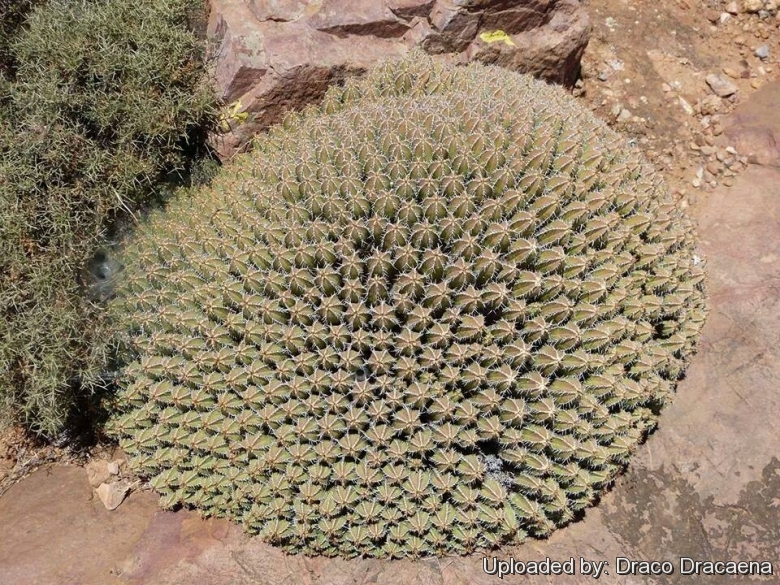
The largest clump in the village Agadir Auguejgal, Anti Atlas, Tiznit, Morocco.
Origin and Habitat: Morocco. It is endemic to the southwest of the country, where it grows in lowland and coastal habitats as well as high up in the Anti-Atlas.
Habitat: Sub-Mediterranean Shrubland and degraded dry forest in the littoral region of the stone-desert of Tindouf and Zemmour, often on rocky hillsides and pebble and gravel lower scree slopes, but also, on shallow rocky soils and in wind-swept places near the sea. The succulent water-storing stems and its low transpiration rate ensures that sufficient water is retained until the next rains. It is quite common and is often found along with Euphorbia beaumierana, Euphorbia regis-jubae, Euphorbia resinifera, and Senecio anteuphorbiumSN|19323]]SN|19323]].
Synonyms:
See all synonyms of Euphorbia officinarum
Common Names include:
BERBER (Tamaziɣt , Tamazigh): Tikiwt
Description: Euphorbia officinarum subs. echinusSN|13375]]SN|13374]], best known as Euphorbia echinusSN|13374]]SN|13375]], is a spiny, cactus-like, succulent shrub densely branched from the base, with up to 100 branches forming compact, hemispherical or variously shaped, bunches reaching about 1 metre tall, but perhaps 3 metres across, so that they resemble a giant spiny hedgehog crouching the ground.
Stems: Main stem (trunk) shorter than the branches. Branches numerous, green, up to 1 m tall, 4-5 cm in diameter, turned upwards with a slight bow-shaped curve and usually with 5-8 shallow ribs, but occasionally there may be more ribs (up to 13).
Spine shields: 4-5 mm in diameter, pale buff, joined in a horny margin.
Spines: Slender, paired, very pointed, 4-10(-15) mm long, about 6 mm apart.
Inflorescence: Solitary cymes, 1- to 2-forked; peduncles short.
Flowers: Cyathia 3-4 mm on diameter, dull red; Nectar gland elliptic, dark red.
Fruit: 3-lobed capsules, subglobose, about 4-5 mm in diameter on slender curved stalks.
Seeds: Irregularly wrinkled.
Subspecies, varieties, forms and cultivars of plants belonging to the Euphorbia officinarum group
Bibliography: Major references and further lectures
1) Hermann Jacobsen “A handbook of succulent plalnts: Abromeitiella to Euphorbia” Blandford Press, 1960
2) Urs Eggli “Illustrated Handbook of Succulent Plants: Dicotyledons” Springer, 2002
3) G. E. Wickens “Ecophysiology of Economic Plants in Arid and Semi-Arid Lands” Springer, 02/set/1998
4) Nathaniel Harris “Atlas of the World's Deserts” Taylor & Francis, 09/ott/2003
5) Peter Haggett “Encyclopedia of World Geography, Volume 24” Marshall Cavendish, 01/lug/2001
6) James Cullen, Sabina G. Knees, H. Suzanne Cubey “The European Garden Flora Flowering Plants: A Manual for the Identification of Plants Cultivated in Europe, Both Out-of-Doors and Under Glass” Cambridge University Press, 11/ago/2011
7) Werner Rauh “The Wonderful World of Succulents: Cultivation and Description of Selected Succulent Plants Other Than Cacti” Smithsonian Institution Press, 1984
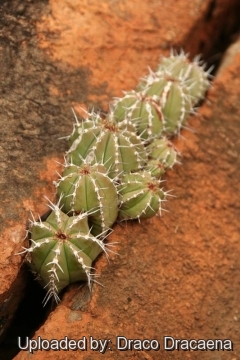 Habit at Mount Imzi, Anti Atlas, Morocco. (Euphorbia officinarum subs. echinus) Photo by: Draco Dracaena
Habit at Mount Imzi, Anti Atlas, Morocco. (Euphorbia officinarum subs. echinus) Photo by: Draco Dracaena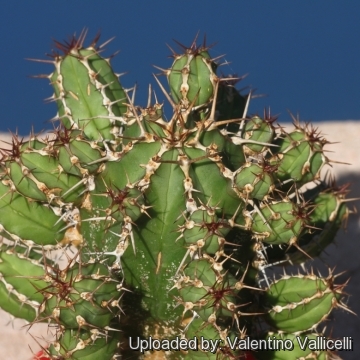 Euphorbia echinus (Euphorbia officinarum subs. echinus) Photo by: Valentino Vallicelli
Euphorbia echinus (Euphorbia officinarum subs. echinus) Photo by: Valentino Vallicelli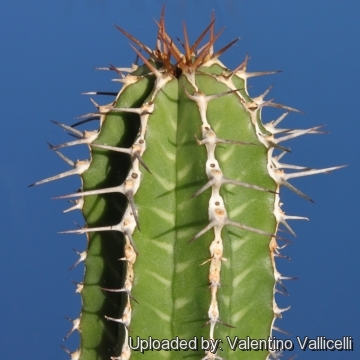 Euphorbia echinus (Euphorbia officinarum subs. echinus) Photo by: Valentino Vallicelli
Euphorbia echinus (Euphorbia officinarum subs. echinus) Photo by: Valentino Vallicelli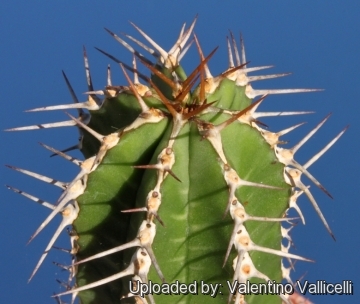 Euphorbia echinus (Euphorbia officinarum subs. echinus) Photo by: Valentino Vallicelli
Euphorbia echinus (Euphorbia officinarum subs. echinus) Photo by: Valentino Vallicelli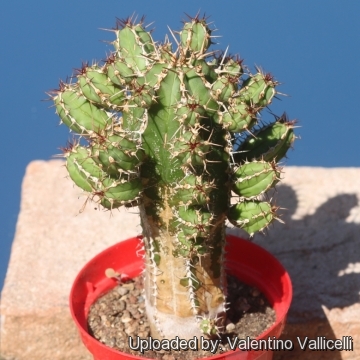 Euphorbia echinus (Euphorbia officinarum subs. echinus) Photo by: Valentino Vallicelli
Euphorbia echinus (Euphorbia officinarum subs. echinus) Photo by: Valentino Vallicelli Euphorbia echinus (Euphorbia officinarum subs. echinus) Photo by: Valentino Vallicelli
Euphorbia echinus (Euphorbia officinarum subs. echinus) Photo by: Valentino VallicelliCultivation and Propagation: Euphorbia echinus is another easy plant to grow often sold at garden outlet centers. It makes great potted specimens.
Growth rate: It grows well, though slowly, but it possible to increase the speed of growth to some extent by providing adequate amount of water, warmth, and a liquid fertilizer diluted half strength during the active growing season, but it’s susceptible to rotting if too wet. Most plants will offset readily, and large bushes can be produced in a few years.
Soil: Likes porous substrata with adequate drainage. Outdoors it does well on poor, rocky soils.
Exposure: Need bright light (also blasting sun in summer) to partial shade for best appearance. It responds well to warmth, with its active growth period in the late spring and summer months. If grown indoor provide 4 to 6 hours, or more, direct morning or afternoon sun.
Watering: Water thoroughly when soil is dry to the touch during active growing season (more than once a week during hot weather) In the winter months, waterigs should be suspended or restricted to once over the winter. The most common failure in growing this plant is over watering, especially during the winter months.
Hardiness: Protect from frost. During winter month, put them in a cool luminous place and encourage them to enter winter dormancy by withholding water and fertiliser over the winter as they will etiolate, or become thin, due to lower levels of light.
Maintenance: Repot every two years. Needs lots and lots of space to grow, use large shallow container filled with very porous compost. It like pots with generous drain holes.
Reproduction: It is propagated by cuttings or seeds. The seeds may be germinated and grown in containers. Their main requirements consist of high humidity levels, free-draining soil mix, and enough water, light, and nutrition. It is recommend taking Euphorbia cuttings in Spring/Summer when the plant is growing so that they have a better chance of success. They key is heat & good air circulation. These cuttings should be dipped in Hormone powder (but it is not needed) and left for a period of 3-4 weeks to callous. Then pot the cutting and don't water ( or kept slightly moist) until rooted. These will root just fine, if you can put the pot outside in the summer, or put pot on a heating pad.
Warning: As with all other Euphorbias when a plant get damaged it exudes a thick white milky sap known as latex. This latex is poisonous and particularly dangerous for the eyes, skin and mucous membranes. So pay extreme attention not to get any in your eyes or mouth. Cultivated plants must be handled carefully.

















